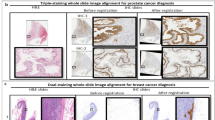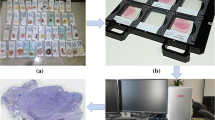Abstract
Staining condition is one of the essential properties in digital pathology for developing computer-aided diagnosis (CAD) systems; however, it is challenging to analyze the staining condition of giga-pixel whole-slide images (WSIs) due to the high data volume. In this study, we proposed an intuitive method to visualize the color style of Hematoxylin and Eosin (H&E) stained WSIs, which is scalable to large real-world cohorts. For this, representative color spectrums are obtained by K-means clustering on slide-level, and the pair-wise distance between spectrums is formulated as a matching problem. Lastly, we use multi-dimensional scaling (MDS) algorithm to obtain 2-dimensional embeddings for WSIs, which are suitable for visualization. We validated the method on lung adenocarcinoma cases and lung squamous-cell carcinoma cases in The Cancer Genome Atlas (TCGA) program. Through the well-visualized staining pattern map, slides with low staining quality or with abnormal staining conditions can be easily recognized. Furthermore, we give a demo usage of the proposed method in the context of a lung cancer segmentation task. Our main conclusions including, (1) biases in staining pattern distribution will harm the performance of CAD systems; (2) weakly stained slides are more challenging than heavily stained slides; (3) stain augmentation can deal with a certain level of staining variation, but not all of it; (4) light stain augmentation can generate more realistic training samples.









Similar content being viewed by others
References
Bándi P et al (2017) Comparison of different methods for tissue segmentation in histopathological whole-slide images. In: 2017 IEEE 14th International Symposium on Biomedical Imaging (ISBI 2017). IEEE, pp 591–595
Bándi P, Balkenhol M, van Ginneken B, van der Laak J, Litjens G (2019) Resolution-agnostic tissue segmentation in whole-slide histopathology images with convolutional neural networks. PeerJ 7:e8242
Bejnordi BE et al (2017) Diagnostic assessment of deep learning algorithms for detection of lymph node metastases in women with breast cancer. Jama 318:2199–2210
Clarke EL, Treanor D (2017) Colour in digital pathology: a review. Histopathology 70:153–163
Di Franco C, Bini E, Marinoni M, Buttazzo GC (2017) Multidimensional scaling localization with anchors. In: 2017 IEEE International Conference on Autonomous Robot Systems and Competitions (ICARSC). IEEE, pp 49–54. https://doi.org/10.1109/ICARSC.2017.7964051
Gadermayr M, Gupta L, Appel V, Boor P, Klinkhammer BM, Merhof D (2019) Generative adversarial networks for facilitating stain-independent supervised and unsupervised segmentation: a study on kidney histology. IEEE Trans Med Imaging 38:2293–2302
Gertych A, Swiderska-Chadaj Z, Ma Z, Ing N, Markiewicz T, Cierniak S, Salemi H, Guzman S, Walts AE, Knudsen BS (2019) Convolutional neural networks can accurately distinguish four histologic growth patterns of lung adenocarcinoma in digital slides. Sci Rep 9:1–12
Hanna MG, Reuter VE, Hameed MR, Tan LK, Chiang S, Sigel C, Hollmann T, Giri D, Samboy J, Moradel C, Rosado A, Otilano JR III, England C, Corsale L, Stamelos E, Yagi Y, Schüffler PJ, Fuchs T, Klimstra DS, Sirintrapun SJ (2019) Whole slide imaging equivalency and efficiency study: experience at a large academic center. Mod Pathol 32:916–928
Jiao Y, Li J, Qian C, Fei S (2021) Deep learning-based tumor microenvironment analysis in colon adenocarcinoma histopathological whole-slide images. Computer Methods and Programs in Biomedicine 106047. https://doi.org/10.1016/j.cmpb.2021.106047
Jiao Y, van Rijthoven M, Li J et al (2021) Automatic Lung Cancer Segmentation in Histopathology Whole-Slide Images with Deep Learning. In: 2021 17th European Congress on Digital Pathology (ECDP2021) 2-2
Khan AM, Rajpoot N, Treanor D, Magee D (2014) A nonlinear mapping approach to stain normalization in digital histopathology images using image-specific color deconvolution. IEEE Trans Biomed Eng 61:1729–1738
Khan A, Atzori M, Otálora S, Andrearczyk V, Müller H (2020) Generalizing convolution neural networks on stain color heterogeneous data for computational pathology. In: Tomaszewski JE, Ward AD (eds) Medical Imaging 2020: Digital Pathology, vol 26. SPIE. https://doi.org/10.1117/12.2549718
Kingma DP, Ba J (2014) Adam: A method for stochastic optimization. arXiv preprint arXiv:1412.6980
Koledoye MA, Facchinetti T, Almeida L (2017) MDS-based localization with known anchor locations and missing tag-to-tag distances. In: 2017 22nd IEEE International Conference on Emerging Technologies and Factory Automation (ETFA). IEEE, pp 1–4. https://doi.org/10.1109/ETFA.2017.8247768
Kothari S et al (2011) Automatic batch-invariant color segmentation of histological cancer images. In: 2011 IEEE International Symposium on Biomedical Imaging: From Nano to Macro. IEEE, pp 657–660. https://doi.org/10.1109/ISBI.2011.5872492
Krizhevsky A, Sutskever I, Hinton GE (2012) Imagenet classification with deep convolutional neural networks. Adv Neural Inf Proces Syst 25:1097–1105
Lafarge MW, Pluim JPW, Eppenhof KAJ, Veta M (2019) Learning domain-invariant representations of histological images. Front Med 6:162
Li X, Plataniotis KN (2015) A complete color normalization approach to histopathology images using color cues computed from saturation-weighted statistics. IEEE Trans Biomed Eng 62:1862–1873
Li B, Keikhosravi A, Loeffler AG, Eliceiri KW (2021) Single image super-resolution for whole slide image using convolutional neural networks and self-supervised color normalization. Med Image Anal 68:101938
Litjens G et al (2018) 1399 H&E-stained sentinel lymph node sections of breast cancer patients: the CAMELYON dataset. GigaScience 7:giy065
Macenko M et al (2009) A method for normalizing histology slides for quantitative analysis. In: 2009 IEEE International Symposium on Biomedical Imaging: From Nano to Macro. IEEE, pp 1107–1110. https://doi.org/10.1109/ISBI.2009.5193250
Magee D et al (2009) Colour Normalisation in Digital Histopathology Images. 12
McInnes L, Healy J, Melville J (2020) UMAP: Uniform Manifold Approximation and Projection for Dimension Reduction. arXiv:1802.03426 [cs, stat]
Mukhopadhyay S et al (2018) Whole slide imaging versus microscopy for primary diagnosis in surgical pathology. Am J Surg Pathol 42:14
Niethammer M, Borland D, Marron JS, Woosley J, Thomas NE (2010) Appearance Normalization of Histology Slides. In: Wang F, Yan P, Suzuki K, Shen D (eds) Machine Learning in Medical Imaging, vol 6357. Springer, Berlin Heidelberg, pp 58–66
Reinhard E, Adhikhmin M, Gooch B, Shirley P (2001) Color transfer between images. IEEE Comput Grap Appl 21:34–41
Ronneberger O, Fischer P, Brox T (2015) U-net: Convolutional networks for biomedical image segmentation. In: International Conference on Medical image computing and computer-assisted intervention. Springer, pp 234–241
Roy S, Kumar Jain A, Lal S, Kini J (2018) A study about color normalization methods for histopathology images. Micron 114:42–61
Ruifrok AC, Johnston DA (2001) & others. Quantification of histochemical staining by color deconvolution. Anal Quant Cytol Histol 23:291–299
Salvi M, Michielli N, Molinari F (2020) Stain color adaptive normalization (SCAN) algorithm: separation and standardization of histological stains in digital pathology. Comput Methods Prog Biomed 193:105506
Salvi M, Acharya UR, Molinari F, Meiburger KM (2021) The impact of pre- and post-image processing techniques on deep learning frameworks: a comprehensive review for digital pathology image analysis. Comput Biol Med 128:104129
Senaras C, Niazi MKK, Lozanski G, Gurcan MN (2018) DeepFocus: detection of out-of-focus regions in whole slide digital images using deep learning. PLoS One 13:e0205387
Shin SJ (2021) Style transfer strategy for developing a generalizable deep learning application in digital pathology. Computer Methods and Programs in Biomedicine 9
Shrestha P, Hulsken B (2014) Color accuracy and reproducibility in whole slide imaging scanners. J Med Imag 1:027501
Stacke K, Eilertsen G, Unger J, Lundström C (2019) A closer look at domain shift for deep learning in histopathology. arXiv:1909.11575 [cs]
Stacke K, Eilertsen G, Unger J, Lundstrom C (2021) Measuring domain shift for deep learning in histopathology. IEEE J Biomed Health Inform 25:325–336
Swiderska-Chadaj Z, de Bel T, Blanchet L, Baidoshvili A, Vossen D, van der Laak J, Litjens G (2020) Impact of rescanning and normalization on convolutional neural network performance in multi-center, whole-slide classification of prostate cancer. Sci Rep 10:14398
Tellez D et al (2018) H and E stain augmentation improves generalization of convolutional networks for histopathological mitosis detection. In: Medical Imaging 2018: Digital Pathology vol. 10581 105810Z. International Society for Optics and Photonics
Tellez D, Litjens G, Bándi P, Bulten W, Bokhorst JM, Ciompi F, van der Laak J (2019) Quantifying the effects of data augmentation and stain color normalization in convolutional neural networks for computational pathology. Med Image Anal 58:101544
Tolkach Y, Dohmgörgen T, Toma M, Kristiansen G (2020) High-accuracy prostate cancer pathology using deep learning. Nat Mach Intell 2:411–418
van der Maaten L, Hinton G (2008) Visualizing data using t-SNE. J Mach Learn Res 9:2579–2605
Yagi Y (2011) Color standardization and optimization in whole slide imaging. Diagn Pathol 6:S15
Yang M, Nurzynska K, Walts AE, Gertych A (2020) A CNN-based active learning framework to identify mycobacteria in digitized Ziehl-Neelsen stained human tissues. Comput Med Imaging Graph 84:101752
Zarella MD, Yeoh C, Breen DE, Garcia FU (2017) An alternative reference space for H&E color normalization. PLoS One 12:e0174489
Zhu J-Y, Park T, Isola P, Efros A A (2020) Unpaired Image-to-Image Translation using Cycle-Consistent Adversarial Networks. arXiv:1703.10593 [cs]
Availability of data and material
Not applicable.
Code availability
We will make the code publicly available at https://github.com/jiaoyiping630/Stain_visualization.
Author information
Authors and Affiliations
Corresponding author
Ethics declarations
Ethics approval
The whole slide images are publicly available through the TCGA program (https://portal.gdc.cancer.gov/) without any restrictions.
Consent to participate
Not applicable.
Consent for publication
All the authors agree with the submission of this manuscript.
Conflict of interest
The authors declare that no conflicts of interest exist in this manuscript.
Additional information
Publisher’s note
Springer Nature remains neutral with regard to jurisdictional claims in published maps and institutional affiliations.
Rights and permissions
About this article
Cite this article
Jiao, Y., Li, J. & Fei, S. Staining condition visualization in digital histopathological whole-slide images. Multimed Tools Appl 81, 17831–17847 (2022). https://doi.org/10.1007/s11042-022-12559-y
Received:
Revised:
Accepted:
Published:
Issue Date:
DOI: https://doi.org/10.1007/s11042-022-12559-y




